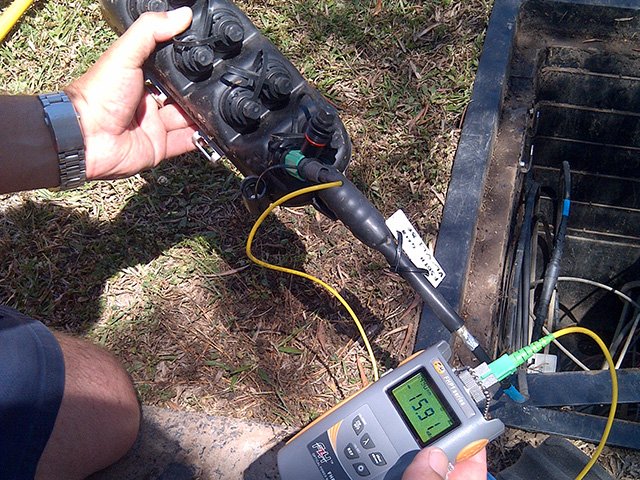Unveiling the Key Utilizes of Optical Fibre Testing for Reliable Information Transmission
In the realm of contemporary communication, optical fiber testing arises as an essential technique for optimizing information transmission. Comprehending the multifaceted applications of optical fiber testing invites a much deeper exploration into its pivotal duty in forming the future of information communication.

Value of Optical Fiber Screening
The value of optical fibre screening can not be overstated, as it works as an important part in ensuring the reliability and effectiveness of information transmission systems. In a period where high-speed interaction is extremely important, any shortages in fibre optics can lead to significant data loss and lowered efficiency. Strenuous screening methods are necessary to verify the honesty and performance of optical cords.
Checking enables for the recognition of issues such as micro-bends, macrobends, and splice losses that might hinder signal top quality. Furthermore, it gives understandings right into the general attenuation and transmission capacity capacities of the fibre, ensuring that the network fulfills specific functional requirements. Normal screening not just enhances system performance but additionally extends the lifespan of the framework by determining possible issues prior to they rise into pricey failures.

Kinds of Optical Fiber Tests
Different kinds of optical fiber tests are performed to make sure the efficiency and integrity of fibre optic networks. These tests can be categorized into a number of vital kinds, each offering a specific function in examining the integrity of the fiber.
First, Optical Time Domain Reflectometry (OTDR) is a famous examination that recognizes mistakes, interlaces, and adapters within the fibre. By sending pulses of light and evaluating the shown signals, technicians can identify concerns along the fibre's size.
2nd, insertion loss tests evaluate the amount of signal loss when light go through connectors or splices, which is critical for maintaining network efficiency.
Third, return loss tests gauge the quantity of light reflected back in the direction of the resource, supplying understandings into the top quality of links and prospective sources of interference.
In addition, continuity tests make certain that the fiber course is total, permitting specialists to verify that the fibre is intact with no breaks. optical fibre testing equipment.
Finally, aesthetic mistake locators make use of visible light to determine breaks or extreme Home Page bends in the fibre, helping in fast troubleshooting. Collectively, these tests create an extensive method to maintaining ideal performance in fiber optic networks.

Applications in Network Upkeep
In contemporary telecommunications, reliable network maintenance counts greatly on optical fibre screening to determine and remedy concerns promptly. Routine screening ensures that the network operates at optimum performance degrees, lowering downtime and improving user experience.
Among the main applications of optical fibre screening in maintenance is the detection of faults, such as breaks, bends, or inappropriate links. Methods like check my blog Optical Time Domain Name Reflectometry (OTDR) allow professionals to locate these concerns accurately and assess the top quality of the fiber link. Additionally, loss testing verifies the integrity of the optical course, making sure that signal attenuation continues to be within acceptable limitations.
Regular maintenance screening likewise aids in safety nets, determining possible issues prior to they intensify into significant failures. This aggressive technique can save organizations both time and financial resources. Moreover, during upgrades or expansions, optical fiber testing makes sure that new setups incorporate flawlessly with existing facilities.
Enhancing Information Transmission Reliability
Reliable network upkeep through optical fibre screening not only addresses immediate issues but additionally plays a considerable role in improving information transmission reliability. By determining mistakes, measuring signal loss, and assessing the general problem of fibre optic cables, screening ensures that prospective issues are corrected before they escalate right into considerable interruptions.
Regular optical fiber testing, such as time-domain reflectometry (TDR) and optical time-domain reflectometry (OTDR), permits service technicians to pinpoint the specific locations of breaks, flexes, or connector problems within the network. This proactive approach not only minimizes downtime however also maximizes the performance of data transmission by ensuring that the paths for signals are clear and functioning efficiently.
In addition, testing help in verifying adherence to market criteria and specifications, which is crucial for keeping the honesty of information flow. By ensuring that each link meets required thresholds for loss and top quality, companies can boost their confidence in the integrity of their information networks.
Inevitably, buying detailed optical fiber screening not only boosts information transmission reliability however also supports the lasting functional effectiveness of interaction infrastructures.
Future Trends in Fiber Screening
Emerging modern technologies are poised to change fibre screening, leading the way for enhanced efficiency and precision in information transmission diagnostics (fibre testing equipment). As the demand for faster net and greater bandwidth continues to rise, the combination of sophisticated devices such as fabricated intelligence (AI) and artificial intelligence (ML) check out here is established to transform standard fibre testing approaches. These technologies will certainly allow predictive maintenance and automated mistake discovery, dramatically decreasing downtime and improving network reliability
In addition, the adoption of Web of Points (IoT) devices will certainly help with real-time tracking of fibre networks, enabling for immediate recognition of efficiency issues. This change towards positive administration will minimize disturbances and enhance data circulation.
Furthermore, advancements in optical time-domain reflectometry (OTDR) and brand-new screening requirements will enhance the precision of measurements, making sure that information stability is preserved throughout the transmission process. The arrival of 5G innovation additionally demands the development of much more sophisticated fibre testing strategies to sustain its high-speed demands.
Conclusion
To conclude, optical fiber screening is essential for keeping reliable data transmission within interaction networks. By using various screening techniques, such as OTDR and insertion loss tests, possible mistakes can be recognized and remedied, thereby improving signal clarity and reducing downtime. Routine screening not only makes sure compliance with market criteria but also helps with aggressive maintenance, eventually adding to the long-lasting reliability and efficiency of fibre optic systems. The ongoing development of screening methodologies will even more strengthen these capabilities in the future.